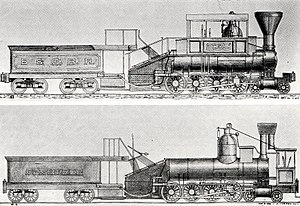Locomotive wheel arrangement
4-8-0 (Twelve-wheeler [1][2]) Front of locomotive at left |
 The Centipede as built (bottom) and as modified by the B&O Railroad (top) |
|
|
|
| First known "True type" version |
|---|
| First use | 1882 |
|---|
| Country | United States |
|---|
| Locomotive | 229 Mastodon |
|---|
| Railway | Central Pacific Railroad |
|---|
| Designer | Andrew Jackson Stevens |
|---|
| Builder | Central Pacific Sacramento shops |
|---|
| Evolved from | 2-8-0 |
|---|
| Evolved to | 4-8-2 |
|---|
| Benefits | Better power than 2-8-0 |
|---|
| Drawbacks | Small firebox |
|---|
|
Under the Whyte notation for the classification of steam locomotives, 4-8-0 represents the wheel arrangement of four leading wheels on two axles, usually in a leading truck or bogie, eight powered and coupled driving wheels on four axles and no trailing wheels. In North America and in some other countries the type was usually known as the Twelve-wheeler.[1][2]

